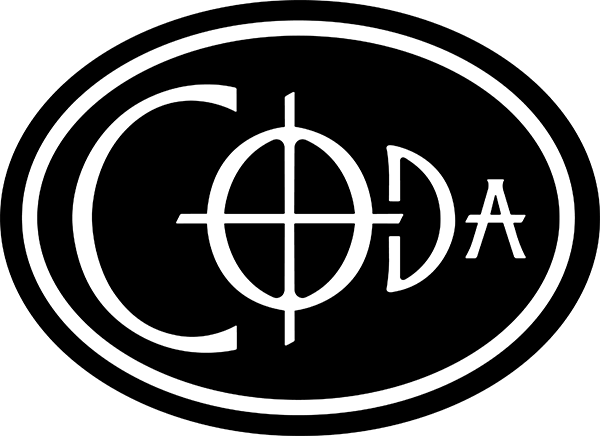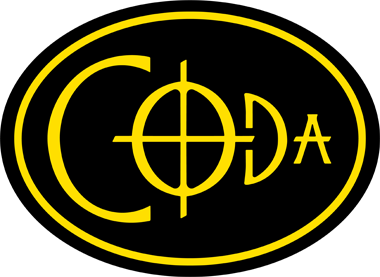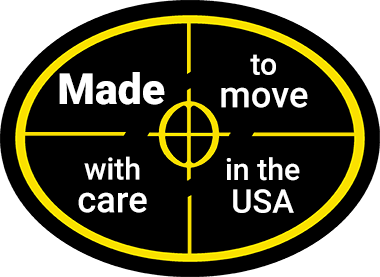Tactile Tour of Coda
Before you listen to the Fingering Charts for Coda EDC Flutes, I’d like to take you on a tactile tour of Coda.
And I’ll take a moment, right before our tour, to mention a basic concept that may help you to quickly grasp how Coda works. Essentially, Coda is two flutes combined into one tough, light, compact package. There is an upper range flute –for the higher notes– surrounded by a lower range flute. In other words, there are actually two sound chambers, but there is only one set of tone holes, or finger holes, that unites the two flutes into one. That’s why Coda can produce such a wide range of notes and still fit in the palm of your hand, or clip onto your belt if you got the optional Coda Clip.
So let’s start our tour. Ideally, you’ll want to have Coda in your hands while I introduce you to Coda.
So, take Coda in your hands. You’ll notice that Coda has two ends. There is a pointed end, sort of like a bird’s beak, except that the tip of the beak is flattened, so it doesn’t come to a sharp point. The beak end is the one that you blow into. And then there’s the tail end, which is sort of rounded. More about that later. By the way, if your Coda has a Clip on it, you can feel the Clip toward the tail end, on the bottom of Coda.
Let’s go back to the beak end, which is called the mouthpiece. Soon you’ll be blowing into the tip of the beak, or the mouthpiece, to make sound, but not yet! (You did it anyway, didn’t you?! Sigh…)
So, we’ve mentioned the mouthpiece end and the tail end of Coda.
But how can you tell the top of Coda (where you’ll put your four fingers of each hand) from the bottom of Coda (where you’ll put your two thumbs)? Well, the tip of the mouthpiece is close to the bottom of Coda.
Just between you and me, I actually had seal and dolphin profiles in mind when designing Coda’s profile, so the tip of the beak is like a wide snout, moving up to a rounded forehead. With that in mind, the snout is at the bottom of Coda, and the rounded forehead is at the top.
So try holding Coda with the mouthpiece pointing toward your mouth. Put the four fingers of each hand on the top of Coda, with your two thumbs supporting the bottom, sort of like you are holding a big sandwich about to take a bite. (What kind of sandwich? Sigh… We’re trying to focus here!)
Now, holding Coda like a sandwich, feel around for a while on the TOP of Coda with the pads of your fingers. Just after the rounded forehead of that smooth mouthpiece, you’ll feel a large engraved oval, about an inch and a quarter wide. Inside that oval is the Coda logo, which I’ll briefly describe for you. The logo is subtle, not gaudy in appearance, because it’s black like the body of Coda. It has the letters C O D A, with the C being largest, as if in the foreground, and then each successive letter gets a bit smaller, as though moving into the background. The O is divided by a cross so that it looks like the Coda symbol used in music notation.
Anyway… just after the logo, as you continue to move toward the tail end, you’ll start to notice some concave or scooped out areas for each of your eight fingers. Within those scooped out areas are the tone holes that you cover and uncover to change the pitch on Coda. For now, don’t worry about where to put your thumbs. We’ll focus on the top of Coda before moving to the bottom.
So, on the top of Coda, first find the four scooped out areas for just the RIGHT hand tone holes. Cover those tone holes with the pads of your fingers. By the pads of your fingers, I mean the flat part of your fingers just after your rounded fingertips. Note that the scooped out area for the pinky finger is very close to the tail end of Coda.
I’ll give you a moment to find those four right hand tone holes on the top of Coda. Soon you’ll learn to cover those tone holes consistently with a bit of trial and error and some practice.
Your next task is to find the toneholes for the four fingers on your LEFT hand. These tone holes are in the same location, except on the left side, and they’re a little farther in from the side edge. Note that the left pinky finger tonehole is again very close to the tail end of Coda, but you’ll notice something strange about it. That very small tonehole is on a little raised nub. If you cover the nub, you are covering the tonehole.
Now, here’s something to realize about Coda’s tone holes. Except for that left pinky tonehole on the raised nub, all the other tone holes on the top of Coda are actually divided into two. Each oval tone hole actually has an inner half and an outer half, with a thin wall separating the two halves. Now this is important! You treat the inner and outer halves of each divided tone hole as a single tone hole. What I mean is that when you cover a tonehole, you always cover both the inner half and the outer half at the same time with your finger pad. Just so you know, the outer half of each tone hole controls the lower sound chamber notes, while the inner half controls the upper sound chamber notes. But always think and act as if the two halves were a single tonehole.
We’ll come back to that later. For now, I’m afraid there are more pressing issues. We need to have a serious talk… about where to put your two thumbs.
With the mouthpiece pointed toward you again, feel along the bottom of Coda with your left thumb. Feel the smooth bottom of the mouthpiece, and then work your left thumb slowly toward the tail end. Immediately after the mouthpiece, your thumb falls into a deep groove. That’s not something you cover. Rather, it’s a D-shaped window (like the letter D), also called a voicing, and it’s for Coda’s lower sound chamber. There’s one of those windows for the upper chamber too, but more about that later. For now, I just want to tell you where to put your thumbs, okay? So after that window, there’s a short ramp and Coda loses some thickness. Then you’ll get to a bit longer ramp and Coda becomes slimmer still. So, feel with me: mouthpiece, window, short ramp, longer ramp, and just at the bottom of that longer ramp, you’ll feel the large round left thumb hole. Found it? Good.
So where is the right hand thumb hole? In exactly the same location on the other side of Coda, directly across from the left thumb hole, at the bottom of the ramp where Coda becomes slimmer. However, the ramp feels differently on the right side because the surface is ribbed instead of smooth. Also, the right thumb hole is much smaller than the left thumb hole. In fact, it’s a tiny hole, but we’ve scooped out around it so you can feel it and cover it more easily. FYI, the thumb holes are just round. In other words, the thumb holes don’t have an inner half and an outer half, and they only affect the lower chamber notes. As you’ll notice when we get to the fingering chart, you’ll keep those two thumb holes covered for MOST of Coda’s notes.
So, now you know where to put your fingers and your thumbs. The more you handle Coda, and the more you play Coda, the more natural it will feel to cover those toneholes. Give it time. Eventually Coda will start to feel like an extension of your hands.
How about blowing into the mouthpiece? Well, there are actually two windway entrances, or blowing holes, on Coda: one for each sound chamber. On the tip of the mouthpiece, there is a left windway entrance and a right windway entrance. You can feel those with your fingertip, and maybe try slipping a fingernail into them to feel exactly where they are. You’ll blow into the left hand side of the mouthpiece to play Coda’s lower range of notes, and into the right hand side to play the upper range of notes. As mentioned, Coda is like a flute within a flute. An upper range flute is surrounded by a lower range flute, and a single set of divided toneholes unites these two flutes into a single coordinated flute. We also call those patented divided toneholes “uni-phi” tone holes (U N I P H I) because they unify two flutes into one and they are sort of shaped like the greek letter phi (P H I). Yes, I’m aware that some people pronounce the letter like fee instead of fie! (Sigh!) The point is that these uni-phi tone holes allow you to control two sound chambers with only one set of tone holes, without having to move your fingers to a second set of tone holes like you do on some other instruments.
Now, there are other holes and features on Coda that you don’t ever cover with your fingers, but I should at least mention what they are so you don’t stay up all night, tossing and turning, wondering what they are.
For instance, on the top of Coda, in between the right and left pinky tone holes, you’ll find a tear-shaped lanyard hole. Some people use that lanyard hole to attach a lanyard (bet you didn’t see that coming), to attach Coda to their backpack, or to wear Coda around their neck. Personally, even though I designed that feature into Coda, I don’t use the lanyard hole because I have a clip on my Coda. So I keep Coda clipped to my belt, or a waistband, or to my front pants pocket most of the time. That lanyard hole is there if you need it, but you might never use it.
On the bottom of Coda, you’ll feel a bunch of features. For instance, within an inch of the tail end, you’ll feel a large tuning hole. That cone-shaped hole improves the sound quality and the tuning of Coda’s upper range, but you don’t ever cover that hole. Occasionally a few beginners have mistaken that large tuning hole for the left thumb hole. But you would never do that, right?
If you have a clip on your Coda, the specially designed Clip covers up that tuning hole.
Just after the mouthpiece on the bottom right hand side of Coda are some ribs. Those ribs provide the following: lightweight structural strength, a cool compartment to store the optional Coda Silencers so you always have them on hand, protection for a tiny large chamber tuning hole, and some crosswind protection for the small D-shaped window for the upper chamber.
So what’s the deal with the two D-shaped windows, or voicings? Well, when you blow into the left windway entrance, the precise windway directs air onto the edge in the bigger window to produce sound in Coda’s lower sound chamber. When you blow into the right windway, it directs air onto the edge in the smaller window to produce sound in Coda’s upper sound chamber. Left lower, right higher.
And that will do it for our tactile tour. If you ever have any questions or suggestions about how we might improve this description, please contact us.




